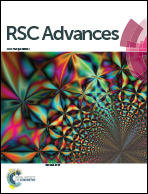Hole-transporting side-chain polystyrenes based on TCTA with tuned glass transition and optimized electronic properties†
Abstract
The development of crosslinkable materials for the fabrication of solution processable OLEDs presents challenges, especially regarding the adjustment of the glass transition (Tg), which has a significant influence on crosslinking kinetics and device life-time. Crosslinkable hole transport materials based on poly(N,N-bis(4-(9H-carbazol-9-yl)phenyl)-4-vinylaniline) (poly-TCTA) with covalently attached plasticizers for Tg control and azide functionalities for azide-alkyne crosslinking are presented. These polymers have an optimal Tg of around 150 °C and show superior crosslinking performances and solution resistibilities. Incorporation of electron-pushing alkoxides to the pendant groups combines the Tg adjustment approach with a systematic tuning of the HOMO level from −5.7 to −5.3 eV. All presented polymers have good charge transport and injection properties and are ideal for applications in phosphorescent OLEDs due to their high triplet energies (>2.8 eV). The new crosslinkable poly-TCTA-based materials are applied as hole-transport layers (HTLs) in fully solution-processed OLEDs. An improvement of the device performance is demonstrated for OLEDs with additional crosslinked HTL.


 Please wait while we load your content...
Please wait while we load your content...